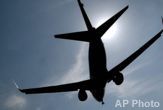Fly the Crowded, Polluted Skies

Air traffic is expected to top 1 billion passengers in the United States by 2015 as facilities become overburdened and global airline officials try to clean up the industry's act.
The Federal Aviation Administration (FAA) provided the growth estimate Thursday. Passengers in the United States are expected to return to pre-2001 levels this year, the FAA said, with 3.4 percent annual growth expected for the next 12 years.
Meanwhile, global air transport industry leaders said Friday that they need to do more to reduce noise and pollution in an industry that suffers a negative public opinion.
Changes ahead
"Deregulation has delivered a dynamic industry where consumers are driving change," said U.S. Secretary of Transportation Norman Mineta. "Airline customers have more options, at lower fares, based on more timely information, than ever before - and our economy is better off as a result."
In 2004, total landings and takeoffs at combined FAA and contract towers rose 0.5 percent, the first increase in activity since 2000.
The expected growth is forcing change.
Get the world’s most fascinating discoveries delivered straight to your inbox.
"We are redesigning airspace, deploying new software that will help increase capacity, and putting new procedures in place," said FAA Administrator Marion C. Blakey. "We will be ready."
The agency, however, faces spending cuts for runways, air traffic control equipment and buildings. The 2006 White House budget would cut funding for airport construction and runways by $500 million, to $3 billion.
David Stempler, president of the Air Travelers Association, said construction is not keeping up with the increase in passengers.
"That just spells congestion and delays for passengers," Stempler said.
Problems in Europe
Separately, about 300 representatives of 1,450 airports in 175 countries met this week in Geneva to discuss negative public opinions toward the industry.
"We urgently need to work on 'greening' our aviation business,'' said Robert Aaronson, director-general of Airports Council International.
Europe is a particular problem area, officials said.
"If we could eliminate delays in Europe, we would also eliminate 15 million minutes of unnecessary flight, US $1.5 billion in wasted operating cost and more than 1 million tons of carbon dioxide emissions,'' said Giovanni Bisignani, director-general of the International Air Transport Association, which represents many of the world's airlines.
The industry leaders said governments should agree they need new technologies and procedures to cut emissions and improve fuel efficiency.
In the United States, regional and commuter airlines will experience the greatest increase in passenger volume this year, up 15.4 percent from last year, according to the FAA report. By 2016, the fleet of jets operated by regional carriers is expected to grow from 1,630 aircraft to 2,960.
International passenger travel in and out of the United States on large commercial and regional air carriers increased from 54.1 million in 2003 to 61.3 million in 2004, or 13.4 percent.
The Associated Press contributed to this report.



